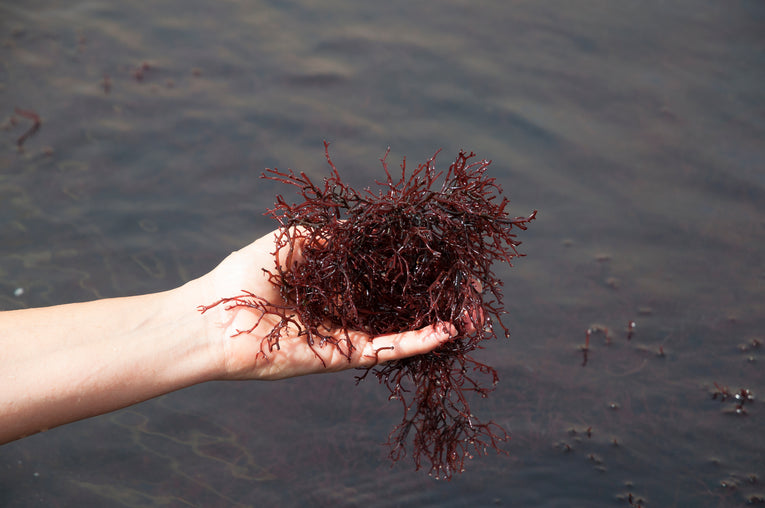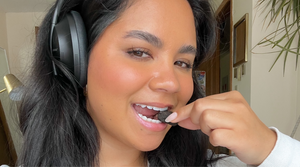Algae is often referred to as a “functional food” due to the many health benefits it has beyond its nutritional value. There are multiple varieties of algae with both similar and unique characteristics that make it valuable as part of a daily diet. The same properties that make it healthy for consumption and daily vitamin supplementation also make it beneficial for the skin. Supplements and topical treatments containing red algae, specifically, benefit the skin from the inside out.
The benefits of red algae for skin range from diminishing fine lines and wrinkles to helping with hyperpigmentation. Compounds extracted from seaweed work with other nutrients, such as vitamins A and C, to deliver a healthier-looking complexion. Here are a few ways it helps preserve and promote better skin health.
Improves Skin Hydration
Changes in the climate, free radicals, makeup, and a range of other factors can all wreak havoc on the skin. The result is a dull, dry appearance that results in flakiness or enlarged, clogged pores. Fortunately, red algae contain antioxidants that prove powerful against dryness and maintain the skin’s natural moisture.
A study conducted by researchers from Kyungpook National University, Korea Institute of Oriental Medicine, and Korea University tested the value of red algae for skin health. Evidence showed its carbohydrates better preserve moisture in the skin and prevent dehydration when compared to hyaluronic acid.1 Additionally, carrageenan from red algae has been used as a moisturizer and emulsifier component in cosmetic products due to the antioxidant and gelling properties of this extract.
Furthermore, red algae is high in potassium and sodium, two electrolytes that enable cells to keep your body’s hydration in check. They help the body retain water and promote hydration, which shows through on your skin.
Fights Acne
Red algae benefits for skin are also due to high levels of beta carotene which the body can convert to vitamin A, better known as retinol. Topical retinol is continually supported as an effective antimicrobial therapy against acne. The American Academy of Dermatology states “retinoids are the core of topical therapy for acne because they are comedolytic [inhibits the formation of blemishes], resolve the precursor micromedone lesion [visible acne lesions], and are anti-inflammatory.” 2
A report authored by researchers from dermatology departments at the University School of Medicine in Philadelphia, PA, Henry Ford Hospital in Detroit, MI, and the Gwinnett Clinical Research Center, Inc. in Snellville, GA showed increased efficacy of retinol on primary acne lesions with increased concentration and effectiveness when used for secondary acne lesions, such as pigmentation and scarring. 3
Topical retinoids promote the acceleration of epidermal turnover to help reduce skin pigmentation and inhibit the transfer of pigmentation to the tissues. This helps to reduce discoloration and uneven skin tones due to hyperpigmentation. Additionally, as an antioxidant, vitamin A protects the skin from free radicals and prevents the buildup of excess oil that results in acne. Plus, different types of red algae extracts also have preservative agents that help prevent environmental contamination of the skin.
Diminishes Fine Lines
Age and sun damage are both catalysts for fine lines appearing on the face. In addition to fighting acne and diminishing clogged pores, there’s research that shows topical retinol, when applied up to three times a week for a period of 24 weeks, reduces the appearance of wrinkles by retaining moisture in the skin and increasing collagen production.
A study conducted by researchers at Pukyong National University in Busan, Korea tested the effectiveness of red marine algae Pyropia yezoensis on anti-aging activities, specifically the production of collagen. They found that Pyropia yezoensis peptide (PYP1-5) increased collagen production by activating the transforming growth factor signaling pathway without affecting cell viability. 4
Other benefits of red algae for skin include using extracts from the Meristoheca dakarenis and Jania rubens species to produce collagen synthesis and keratin used for anti-aging products. Algae also has organic anti-aging properties, including astaxanthin, that improves skin elasticity, leaving it more soft and supple. It also helps to repair cell damage to preserve healthy skin.
Reduces Inflammation
Skin redness caused by inflammation is a common condition that occurs at various levels of severity and frequency. It can be caused by an allergic reaction or bacterial infection. It often results in itchiness, dryness, and chronic inflammation and can often be painful as well. Inflammation is a symptom that a part of the body is irritated or out of balance. Algae helps to create a calming environment through anti-inflammatory properties that reduces redness or blotchiness.
Porphyran, a polysaccharide extracted from red algae, has shown potential anti-inflammatory, skin whitening, and pain relief activities. Porphyran suppresses nitric oxide production, which can cause tissue damage associated with chronic inflammation when there’s too much present in the body.
Offers UV Protection
Algae contains UV blockers that protect the skin from harmful sun rays. These include sulfated polysaccharides and carotenoids. Carrageenans are the most recognized sulfated polysaccharides found in red algae. They’re widely used in food and cosmetic products due to their thickening and gelling properties. Carrageenans have shown significant protection against cell damage by UV light and have decreased the release of reactive oxygen species, which lead to aging skin and cancers. They are also associated with cleaning, hydrating, and antioxidant activities essential for healthy skin.
Carotenoids are found in all photosynthetic organisms, including algae. They absorb energy from the sun and mitigate the harmful effects of UV rays by dissipating excess energy. This is powerful protection for the skin against the sun as well as the protection for the eyes. Research from a study conducted through the University of Sao Paulo, Brazil concluded extracts from red algae extract, Porphyra umbilicalis, combined with vitamins and Ginkgo biloba significantly improved the performance of sunscreen formulas to prevent UV damage and inflammation. 5
Promotes Anti-Cancer Activity
Researchers from Monash University in Malaysia and Jeju National University in Korea, among others, cited anti-cancer effects of metabolites found in algae. For example, fucoxanthin, a carotenoid extracted from red, brown, and green algae, shows evidence of anti-melanogenic and anti-aging activities. 6
A study performed by Kyoto University in Japan concluded that topical treatment with fucoxanthin significantly reduced the size of skin cells affected by UVB rays, which largely contribute to the risk of skin cancer. 7Evidence has also shown that polyphenols extracted from plant-based sources have an impact on inhibiting skin cancer and reducing tumor multiplicity. The effects are valuable when gained through both dietary and topical sources.
The adaptability of marine algae only adds to their beneficial nature. Marine algae can survive harsh conditions, including extreme heat, cold, high salinity, and ultraviolet radiation. For example, algae produce osmolytes that act as antioxidants and heat protectants when under environmental stress. They also adapt to low-moisture environments by producing specialized spores rich in astaxanthin that protects skin cells from sun aging.
Minimizes Hyperpigmentation
To boost the effects of vitamin A to help with pigmentation, studies have shown that agarose, also derived from red algae, has anti-melanogenic activity that aids in evening out skin tone as well. In a study that converted agarose into anhydro-L-galactose, it presented a significantly lower melanin production compared to arbutin, an organic compound derived from a bearberry plant and presented strong anti-inflammatory activity. 8
Moreover, significant levels of vitamin C found in red algae plump and brighten the skin and help to even out skin tone. When there’s a lack of vitamin C in the body, it can often result in poor wound healing, thickening of the outer layer of the skin, and bleeding beneath the skin. Adding vitamin C to a daily diet and using it as a topical treatment for the skin can provide the body what it needs for internal protection and external appearance.
According to a review of studies performed by the University of Otago in Christchurch, New Zealand regarding the role of nutrition for skin health, evidence concluded that dietary intervention involving a high intake of fruits and vegetables with significant levels of vitamin C with a nutrient supplement or through dietary changes improved skin elasticity, color, and texture. 9
Provides Natural Ingredients
The concept of “clean” skincare is one that many prefer over products that contain chemicals or preservatives. Using algae extracts offers a sustainable, plant-based solution for those who want an organic approach to preserving their skin health. The compounds found in seaweed, including polysaccharides, sterols, peptides, and amino acids, are what create bioactivity in the system. These protect the skin against environmental pollutants and improve hydration and texture of the skin.
Red algae for skin is one of the fastest-growing ingredients used in skincare and health supplements today due to the variety of benefits visually apparent. As an adaptive, sustainable resource, it provides a healthy alternative to synthetic ingredients and products. Since these many red algae health benefits are available through both nutritional supplements and topical treatments, it’s easier to incorporate them into a holistic healthcare routine.
Wrapping Up
All varieties of seaweed have long been used for their medicinal effects, including their anti-allergic, anti-tumor, and anti-microbial properties. The advantages algae have for skin health only add to their positive impact. Due to their ability to protect and improve the skin, it’s becoming widely acceptable for beauty products to contain algae as a natural defense.
If you want to learn more about red algae and the benefits it has for skin, visit DailyGEM.co today!
Sources:
1. Valentina Jesumani et al., “Potential Use of Seaweed Bioactive Compounds in Skincare-A Review,” Marine drugs (MDPI, December 6, 2019), https://www.ncbi.nlm.nih.gov/pmc/articles/PMC6950024/.
2. James Leyden, Linda Stein-Gold, and Jonathan Weiss, “Why Topical Retinoids Are Mainstay of Therapy for Acne,” Dermatology and therapy (Springer Healthcare, September 2017), https://www.ncbi.nlm.nih.gov/pmc/articles/PMC5574737/.
3. James Leyden, Linda Stein-Gold, and Jonathan Weiss, “Why Topical Retinoids Are Mainstay of Therapy for Acne,” Dermatology and therapy (Springer Healthcare, September 2017), https://www.ncbi.nlm.nih.gov/pmc/articles/PMC5574737/.
4. Cho-Rong Kim, “Pyropia Yezoensis Peptide Promotes Collagen Synthesis by Activating the TGF-β/Smad Signaling Pathway in the Human Dermal Fibroblast Cell Line Hs27,” International journal of molecular medicine (U.S. National Library of Medicine), accessed January 21, 2021, https://pubmed.ncbi.nlm.nih.gov/27878236/.
5. D G Mercurio and T A L Wagemaker, “In Vivo Photoprotective Effects of Cosmetic Formulations Containing UV Filters, Vitamins, Ginkgo Biloba and Red Algae Extracts,” Journal of photochemistry and photobiology. B, Biology (U.S. National Library of Medicine), accessed January 21, 2021, https://pubmed.ncbi.nlm.nih.gov/26402714/.
6. Thiyagarasaiyar, Krishnapriya, Bey-Hing Goh, You-Jin Jeon, and Yoon-Yen Yow. “Algae Metabolites in Cosmeceutical: An Overview of Current Applications and Challenges.” Marine drugs. MDPI, June 19, 2020. https://www.ncbi.nlm.nih.gov/pmc/articles/PMC7344841/.
7. Valentina Jesumani et al., “Potential Use of Seaweed Bioactive Compounds in Skincare-A Review,” Marine drugs (MDPI, December 6, 2019), https://www.ncbi.nlm.nih.gov/pmc/articles/PMC6950024/.
8. “Enzymatic Production of 3,6-Anhydro-L-Galactose from ...,” accessed January 21, 2021, https://www.researchgate.net/publication/225283039_Enzymatic_production_of_36-anhydro-L-galactose_from_agarose_and_its_purification_and_in_vitro_skin_whitening_and_anti-inflammatory_activities.
9. “11 Vitamin C Serum Benefits: How to Use, Side Effects ...,” accessed January 21, 2021, https://www.healthline.com/health/beauty-skin-care/vitamin-c-serum-benefits.






